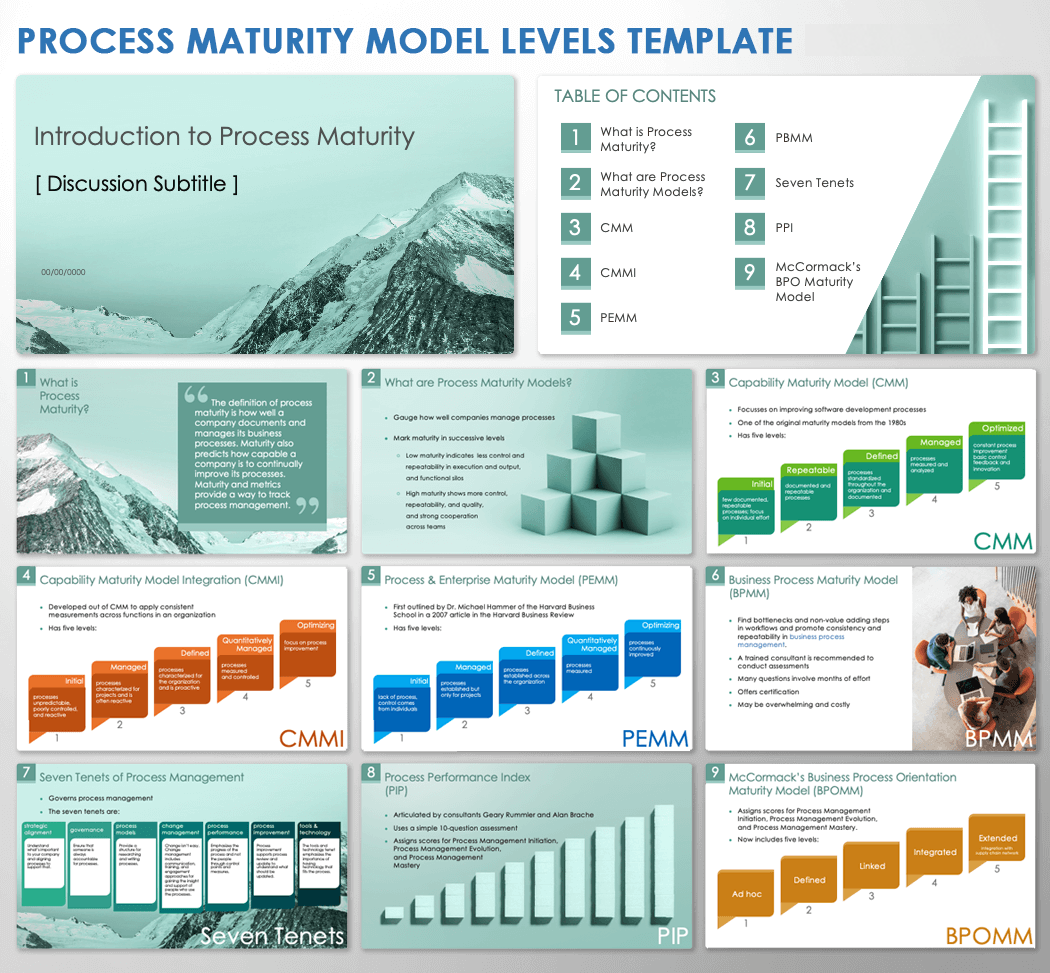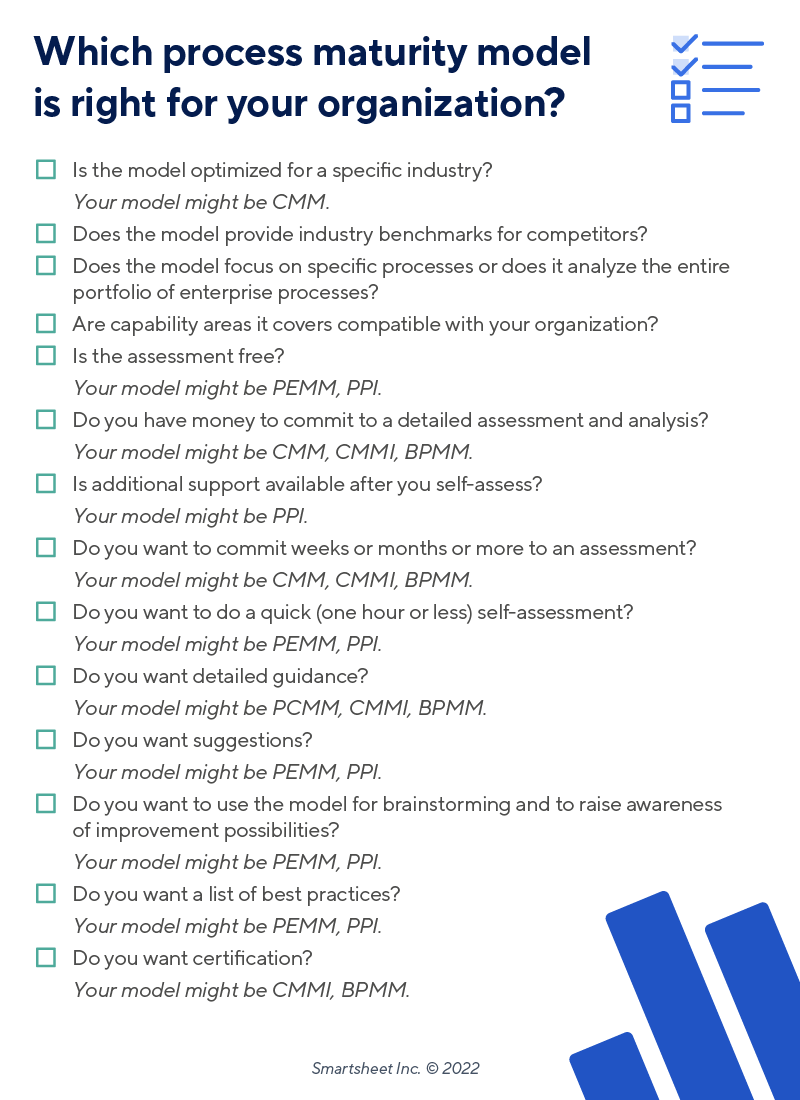What Is Process Maturity?
Process maturity is a measure of how well defined and controlled a company’s processes are. A high level of process maturity shows that a company documents processes well, employees understand and follow procedures, and there is continuous process improvement.
Process maturity can refer either to the maturity of a single process or of all processes in a department or company. Either way, process maturity is a critical gauge of business process health.
Business processes are how companies organize and manage value-generating activities. When a company’s processes are well designed and encourage teamwork and accountability, that company has high process maturity. This leads to higher product quality, customer satisfaction, cost and resource efficiency, and more.
A process is mature when it displays the following characteristics:
- Defined: Process steps are clearly outlined. Inputs consistently produce the same outputs.
- Efficient: The process requires a reasonable amount of effort. Miscommunications and process delays are rare.
- Documented: The process is clearly detailed. Employees know where to find all relevant information.
- Automated: The organization has automated any process steps that are eligible.
- Effective: The process consistently produces anticipated results.
A company has a high level of process maturity when it displays the following characteristics:
- Standardized: Processes are consistent across teams.
- Measured: The company tracks process maturity using consistent metrics, such as KPIs.
- Analyzed: The company regularly evaluates processes for efficiency and effectiveness.
- Continuously Improving: Teams adapt processes as the company grows. Outcomes continue to improve.
| Low-Level | High-Level |
|---|---|
|
|
|
|
|
|
|
|
|
|
|
|
Learn more about how to keep your company efficient and profitable with these comprehensive guides to organizational maturity, project management maturity models, and business process management.
Management officially supports processes.
A process maturity model divides process maturity into levels, from highest to lowest. A model describes the characteristics of each level. By using a model, companies can understand their current maturity level and take steps to improve it.
Process maturity models can serve several purposes. They can be descriptive, meaning they help organizations assess their current processes. They can also be prescriptive, meaning they define optimal process maturity and provide guidance on achieving it. Finally, they can be comparative, meaning they help companies understand how their processes stack up against the competition’s or how they compare between departments.
“Organizations love maturity models because they are like a summary of what they should do,” says Amy Van Looy, Associate Professor with the Faculty of Economics and Business Administration at Ghent University. “Models position maturity in a very approachable manner. However, the real world is quite complex. Models do not completely show reality. Maturity is merely your expected performance.” In order to measure actual performance, you need to set and track performance using standardized metrics, such as KPIs.
Van Looy explains that different models allow you to track specific capabilities or skills that support maturity, such as culture, strategy, and customer satisfaction. For example, a bakery that ships 50 loaves every week and uses bags made of recycled plastic can track both factors to gauge the maturity of their culture and strategy. The bakery can even measure customer satisfaction by asking if they like the bags.
Process maturity models are also important because they may be a requirement for certain certifications. For example, companies applying for the European Foundation for Quality Management (EFQM) Excellence Award must reach a specific maturity level to qualify.
The following process maturity matrix provides an example of maturity levels.
What Is a Process Maturity Level?
Process maturity levels are the evolutionary stages of a maturing process. Most process maturity models have three to seven levels. Each level describes how a company or process should appear before they can progress to the next stage.
Processes mature at different rates, depending on the nature of the process and on how much emphasis a business places on process improvement. Honing skills and capabilities at every maturity level helps lay the groundwork for success. Maturity levels may be inconsistent among processes within both a company and individual departments. Processes might also return to lower maturity levels when no one monitors them and seeks continuous improvement.
Not all organizations or processes require or benefit from reaching the highest maturity levels. High maturity in core processes might serve strategic ends, but lower maturity for non-crucial processes can often suffice. Models don’t specify what level of maturity an organization or process should achieve. “Determining the optimal level is crucial,” says Van Looy, “and maturity models don’t prescribe it. They describe capability areas. They say what you can do with all those capability areas. But it's up to an organization to decide their optimal level, based on their strategy.”
Steps in Process Maturity
Think of each process maturity level as a step. At each step, companies need to achieve certain goals to advance. The number and names of steps vary between models. Most models describe an evolution from ad hoc to optimized processes.
Here are five common steps in process maturity:
- Initial: At the first level, sometimes called the chaotic or ad hoc level, there is minimal focus on processes. Teams and team members each perform processes differently. Processes are not well defined or documented. At this level, process success often depends on the individual employee or team.
- Repeatable: At the second level, teams and departments standardize processes, making outputs predictable and repeatable. Process knowledge still rests with one person or a few people. Individuals or discrete groups may document their processes.
- Defined: At the third level, the entire organization standardizes and documents processes. Knowledge no longer centers on individuals and teams, and cross-functional and cross-team cooperation thrives.
- Managed: At the fourth level, sometimes called the measured level, companies assess and analyze processes. They might also benchmark against industry leaders.
- Optimized: At the fifth and highest level, an organization is continuously improving. The company innovates and demonstrates process leadership for other organizations in its field.
Process Maturity Model Levels Presentation Template
Download a Process Maturity Model Levels Presentation Template for
PowerPoint
| Google Slides
Download this free process maturity model level presentation template to help identify and describe your organization’s current process maturity level or the maturity level of a single process. Add the level names for the maturity model your organization chooses. This process maturity model PowerPoint template includes customizable slides for each level.
Types of Process Maturity Models
Many types of process maturity models are available to choose from. Some are designed for specific fields or industries. Others are created for more general use. Assessments for different models also vary in length and level of detail.
Here are some of the most popular process maturity models:
Process Maturity Framework (PMF)
The roots of process maturity lie in quality management. One of the first models to explore business process maturity was the Process Maturity Framework (PMF). Created in 1980, PMF described an approach for including quality practices in software development. Later, in the 1990s, Total Quality Management showed that statistical process control techniques led to mature processes by reducing variability and increasing efficiency.
Capability Maturity Model (CMM)
One of the original maturity models, the Capability Maturity Model (CMM) was modeled on PMF and has been around since1980. Carnegie Mellon’s Software Engineering Institute developed the model at the behest of the U.S. government, which needed a gauge of process management capabilities for their software contracting partners. CMM, or the Capability Maturity Model, is a framework for improving software development processes. It has five levels of maturity that emphasize increasing repeatability in processes and project management.
Capability Maturity Model Integration (CMMI)
CMMI, which stands for Capability Maturity Model Integration, was developed on the foundation of CMM in order to serve functions outside of software development. Before the creation of CMM, there were many adaptations used for different functions, such as HR and accounting. This made comparing results across an organization difficult. CMMI standardizes the scoring system for all functional areas. First released in 2002, its most recent iteration came out in 2018.
The CMMI framework includes five maturity levels that help teams evaluate and improve processes. There are two approaches to process improvement in CMMI: continuous representation and staged representation. With continuous representation, organizations prioritize the aspects of their business that are most critical and focus on improving process maturity in those areas. With staged representation, organizations seek to improve process maturity across all departments and functions.
In order to receive a CMMI certification, organizations must undergo a complex and labor-intensive assessment program that requires the support of outside consultants. However, for organizations that need proof of process maturity for certain endeavors, such as government fundraising, CMMI continues to be a popular option.
Process and Enterprise Maturity Model (PEMM™)
Created by Dr. Michael Hammer of the Harvard Business School in 2006, the Process and Enterprise Maturity Model, or PEMM™, has roots in Hammer’s earlier work on process reengineering. He advocated for the model as an objective way to test business processes.
Hammer intended the model to be simple enough that organizations could self-administer assessments instead of relying on experts or consultants. This is valuable because employees are more likely to believe in and act on self-assessments than externally generated recommendations. You can apply this framework across an organization to ensure that you have a standardized approach to improving process maturity and a common language for comparing experiences.
According to Hammer’s 2007 article for the Harvard Business Review, all successful business processes have two requirements: process enablers and organizational capabilities. Process enablers are individual processes that are interconnected and depend on one another for success, such as design, performance, process ownership, infrastructure, and metrics. Organizational capabilities are the company’s ability to create a supportive environment for these process enablers. These capabilities include leadership, culture, expertise, and governance.
In order to gauge organization-wide process maturity in PEMM™, you can use Hammer’s evaluating worksheet. Gauge organizational capabilities on a scale of E0 to E4. When all capabilities have reached a certain level, you can begin developing your processes to match that level. Next, download Hammer’s assessing worksheet and rank your process maturity from P0 to P4. These worksheets are both free and can be color-coded to indicate maturity scores in a more visually dynamic way.
Seven Tenets
The American Productivity and Quality Center (APQC), a nonprofit benchmarking and best practices firm, developed the Seven Tenets of process management and offers the Business Process Management Maturity Assessment. This 10-question, multiple-choice online self-assessment provides a framework for improving process maturity.
These are the Seven Tenets of the APQC assessment:
- Strategic Alignment: Teams understand the strategic vision of the company and align processes to support it.
- Governance: Someone is always accountable for process activities, and support systems are in place to help them succeed.
- Process Models: The organization has clear documentation and resources that ensure processes are consistent across the company.
- Change Management: The company has communication, training, and engagement strategies for shifting teams toward a process focus.
- Performance and Maturity: The company tracks the success of processes and process maturity across departments.
- Process Improvement: The company holds regular process reviews to understand what should be updated.
- Tools and Technology: The appropriate resources are available to teach and manage processes.
Process Performance Index (PPI)
The Process Performance Index, or PPI, is a process maturity assessment created by consultants Geary Rummler and Alan Brache for use in any business. In their book, Geary and Brache contend, “An organization is only as good as its processes.”
Their free online assessment includes a simple, 10-question quiz, which they call a “quick organization physical.” Use the assessment to determine a “process health score,” and consult the answer sheet for pointers on advancing to the next level. The assessment places organizations in one of three categories, depending on what their immediate focus should be: process management initiation, process management evolution, or process management mastery.
Other Process Improvement Approaches
Not every process maturity expert recommends maturity models as the best path to process maturity. Giles Johnston, Director and Co-Creator of Fraction ERP, doesn’t use formal models in his work. “I think what's more important than choosing a model is to understand what the model does,” he says. “It’s like giving a car to someone who's never driven before and saying, ‘Take that for a drive around the block. It's faster than walking.’ If you don’t know how to drive a car, it's just pointless.”
Johnston recommends tools such as brainstorming and diagramming to assess and improve process maturity. He explains that people can just as easily break down a business into key processes and functions, as well as ask themselves objectively if processes are effective.
If things don’t look good, here are some steps for a do-it-yourself assessment and analysis:
- Get a Second Opinion: Invite an outsider to review the state of your processes. This person could be a consultant, a friend, or the owner of another company, even one in a different field.
- Review Their Feedback: Ask them for brutal honesty. Look for ideas on what good looks like and what amazing looks like. What does fantastic look like?
- Set Long-Term Goals: Map out a five-year look-ahead across all the business’s main elements, including key business processes. Then map out what must happen year by year, working backward to determine what you need to do to reach goals.
- Create a Plan: Break the business into discrete parts. Ask what different levels of success look like for each piece. Then bring those parts back together to build a picture that reflects the unique business. “Suddenly, you've got a path you could follow that's easy to articulate. You've got something that means something to the people in the business because it's theirs,” says Johnston.
For more resources and information, see these comprehensive guides to defining and mapping processes.
How to Choose a Process Maturity Model
Every process maturity model has pros and cons. When choosing a model for your company, consider what performance areas you want to focus on. Also consider how much time and money you can spend on following the model.
Holly Lyke-Ho-Gland, a principal research lead at APQC, recommends that people identify what they want to optimize in their organization. Then consider how each model approaches that area and whether or not it provides benchmarks. “We can look internally, but we're not going to get very far if all we do is look internally for comparisons,” says Lyke-Ho-Gland. “Once we can benchmark with our industry or adjacent industries, or even some that are a couple of steps away from us, we can understand what performance looks like in context, and then also have an example of how to do those things better.”
Similarly, Van Looy explains that choosing a process maturity model depends on what you hope to achieve. A simple model might offer a quick assessment that helps you begin a conversation on processes. If you want to use benchmarks, you probably need a consultant that has a competitor benchmark database. A smaller company, or a company with low process maturity, will start with a self-assessment and eventually work toward benchmarking.
“I think the problem with any model is how do you apply it and put it into the context of the business and make it meaningful,” adds Johnston. “I think it really is important that people come up with a journey that makes sense to them that they can follow, rather than an esoteric or academic model that's almost impossible to apply to your current, real-life situation.”
Process Maturity Model Selection Checklist
Download the Process Maturity Model Selection Checklist for Adobe PDF
Answer the questions in this process maturity model selection checklist to better understand your priorities for choosing a model. For example, do you want a quick self-assessment or outside help for a detailed analysis? The checklist provides recommendations based on your responses.
How to Use a Process Maturity Model
A company uses a process maturity model to understand its current status and picture what it can achieve. Using a model often means taking an assessment, deciding on a target maturity level, and planning how to reach that level.
Here are the basic steps of using a process maturity model:
- Take an Assessment: Whether self-administered or conducted by a third party, assessments establish your current maturity and capability level.
- Define Your Target Maturity Level: The maturity level you aim for depends on your strategic goals and the area you want to assess. For example, in a car manufacturing company, reaching level five might be necessary for the brake manufacturer. However, reaching level five might be less critical for the janitorial department. Only you can know the optimal level.
- Plan to Advance Maturity: Determine what improvement efforts will help you reach your target maturity stage.
Why Is Process Maturity Important?
Having process maturity means a company is able to pivot quickly. Process maturity also ensures a company can respond to new threats and opportunities. This agility is key to sustaining and growing a business.
“I think process is more important than it's ever been,” says Lyke-Ho-Gland. “Over the last couple of years, we've seen so many broken processes because work was done by individuals rather than people executing a good process. If you have a good process, anyone can step in and take over.”
Van Looy agrees that process maturity is essential for any organization. “Excellence is important nowadays,” she says. “On the one hand, you have globalization, higher competitiveness, and demanding customers. But on the other hand, there are also so many opportunities with emerging technologies.”
Introducing technology or initiating projects when an organization is not ready can lead to failure and disappointment. Working through the stages of maturity should set a solid foundation for ever more ambitious endeavors.
Benefits of Process Maturity
The benefits of increasing process maturity include reduced costs, improved forecasting, and better outputs. First-rate processes produce high-quality products and services. These, in turn, satisfy customers and lead to increased revenues.
Here are some benefits of process maturity:
- Increased Reliability: Mature processes work as intended so that teams can reliably follow customer specifications. “Unless you have some software-driven process or a machine influx process, you rely heavily on people doing what they say they're going to do,” says Johnston, describing an immature process.
- More Realistic Expectations: By identifying current capability levels, process maturity efforts allow management to set realistic expectations. Johnston uses the following example of his daughter’s ice skating lessons: “Her coaches don't make her do all the hard jumps on day one. They start with the basics, build up, assess the performance, and then put her onto more and more complicated stuff. Process maturity acts exactly the same,” he says.
- Improved Benchmarking: Standardized maturity levels help with your internal and external benchmarking efforts.
- Clearer Path to Success: Each process maturity model provides tried-and-tested steps to improvement.
- Easier Automation: When assessing your process maturity level, you’ll need to break down all of your current processes. By doing so, you can more easily see which processes would benefit from automation.
- Improved Forecasting: When processes are measured and controlled, you can better control outcomes. Create more accurate forecasts by improving your process maturity.
- More Effective Goal Setting: By identifying inefficiencies and measuring successes, teams can set more realistic, productive goals to improve their performance.
Challenges of Process Maturity
There are three main challenges in process maturity. The first is defining processes and understanding process orientation. The second is achieving objectivity in process management. The third is capturing process knowledge.
The first challenge of process maturity is that companies need to reorient their focus toward processes. Lyke-Ho-Gland explains that before a company can consider achieving process maturity, it must recognize process orientation as a fundamental principle. “We need to understand that work is a process,” she says.
Another challenge is achieving objectivity in performance management. “I think the biggest challenge we see is teams trying to go from being subjective to being objective in how they manage performance,” states Lyke-Ho-Gland. “People are really good at standardizing, but not really good about identifying measures to ensure they're making those objective decisions, rather than having knee-jerk reactions. Objectivity means focusing on the process, not the individual performer. If one month's performance dips, people must look at performance over time and then know the acceptable variances.”
A final challenge in process maturity is curating and sharing process knowledge. “We usually think, OK, we've documented our processes, we're measuring our processes, we have ownership of our processes,” says Lyke-Ho-Gland. “But what about all the information and knowledge that goes along with executing the processes? How do you ensure that everyone has the information they need to consistently execute well? Or if they have to make decisions, how do they learn the business benefits around this process? And how do we share best practices with other people performing the process so it can be optimized?”
How to Improve Process Maturity
Management can improve process maturity when they lead by example. Management support for change efforts is critical to success. Companies also advance maturity when they inform employees of changes and initiatives.
Johnston explains that improving process maturity often requires a high level of support and consistency from upper management. “If you want that buy-in, you must be seen to be leading by example,” he says. “In process maturity, if you want to run your processes professionally, rather than like an amateur, you've got to live and breathe process maturity every day. You're talking about your policies. You’re openly praising people when they're doing a good job or disciplining people when they're doing a bad job. If leaders want their organization to mature, they must be congruent and consistent with the actions that their teams see daily. I think that's one of the key things that needs to happen for maturity to grow.”
As an example, Johnston describes a company he advised where policy enforcement and reinforcement were haphazard. “The response of the company directors was, ‘Oh, you need to sort this out. Can you rewrite our policy so that we are out of scope?’ And you can imagine my answer was, ‘No, I cannot do that. You need to decide how you want to run your business going forward.’”
Lyke-Ho-Gland also adds that input and buy-in from all levels of the company is important when improving process maturity. “If we're going to attain a certain maturity, we have to engage people and take them along for the ride,” she says. “People have to have a sense of ownership. We have to know we can offer input. If something is happening to us rather than with us, that's when we’ll offer a lot more resistance.”
Optimize Your Business Processes with Real-Time Work Management in Smartsheet
Empower your people to go above and beyond with a flexible platform designed to match the needs of your team — and adapt as those needs change.
The Smartsheet platform makes it easy to plan, capture, manage, and report on work from anywhere, helping your team be more effective and get more done. Report on key metrics and get real-time visibility into work as it happens with roll-up reports, dashboards, and automated workflows built to keep your team connected and informed.
When teams have clarity into the work getting done, there’s no telling how much more they can accomplish in the same amount of time. Try Smartsheet for free, today.




